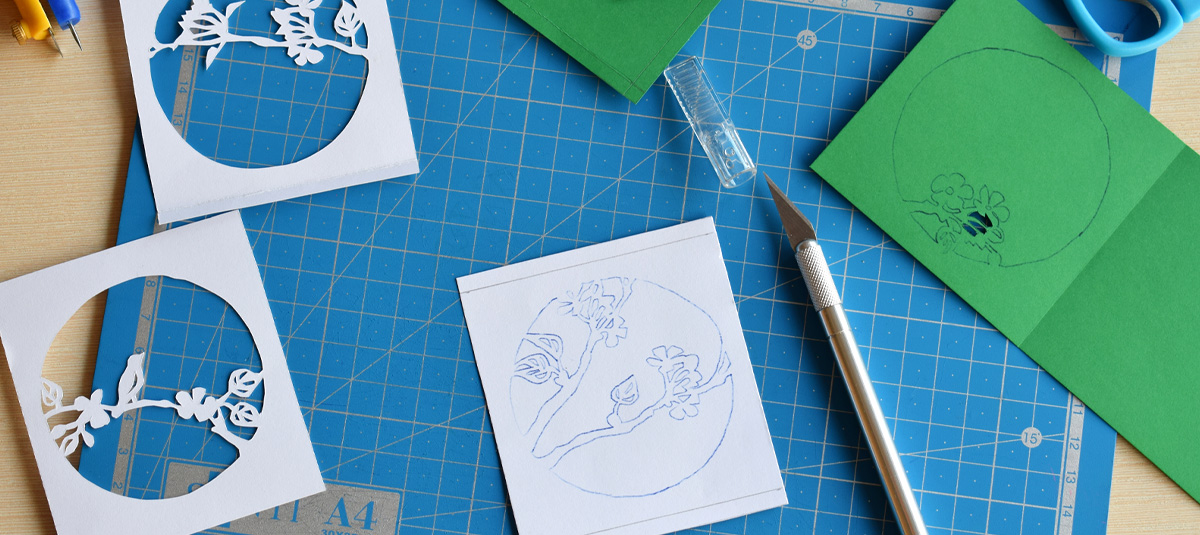Learn How to Cut Card Stock

CUTTING TECHNIQUES FOR FINE ARTISTS AND SCRAPBOOK ENTHUSIASTS
In both fine art and scrapbooking, cutting card stock with precision is vital for bringing your creative vision to life. Whether you’re creating simple square or rectangular images to frame and sell or making intricate embellishments for a scrapbook layout, the proper cutting method can make all the difference in how the final product looks.
In this article, we’ll explore various tools and tricks for cutting card stock, including an array of paper cutters/trimmers, X-ACTO® knives, swivel-tip knives, “fussy cutting” with scissors, and Cricut® machines.
FIRST: WHAT IS CARD STOCK?
As the name implies, card stock is thicker and more robust than other paper types. One of the benefits is its sturdiness. The thickness and weight of card stock make it a durable medium that can easily withstand handling, folding, and transportation without creasing or tearing. Suggested uses of card stock include greeting cards, postcards, photo printing, portfolio production, business cards, books, and calendars.
A Word on Paper Weight. Paper weight is the basic way to understand a paper’s feel and suitability for a project. You can use paper weight as a proxy for sturdiness, thickness, and weight. As a rule, the higher the number, the thicker and sturdier the card.
Several standards are used when measuring paper weight. The most prevalent in the United States are the Cover basis and Bond basis weight. Grams per square meter (GSM), is the "worldwide" standard for paper weight. GSM is an easy way to quickly compare the weight (density) of papers. Card stock falls within 230 to 330 GSM. See this helpful paper weight chart for measurement comparisons and uses of different weights of paper.
Card stock also offers a broad range of textures and finishes. You can find options like linen, canvas, or embossed, adding an extra dimension and visual interest to your prints. These variations make cardstock a versatile choice for creative projects where the tactile feel and texture are as important as the visual aspect.
If you want to print on your card stock before cutting, check out our resource, Printer Adjustments for Thick Papers. It will walk you through raising the print head on various Epson and Canon printers.

PAPER CUTTERS AND TRIMMERS: GIVE IT TO ME STRAIGHT
Fine artists and scrapbookers alike often need the ability to cut super-straight lines. Scissors are not the answer! Let’s explore some more reliable options.
Rotary Paper Trimmers/Cutters. Sitting flat on your desk or work table, rotary paper trimmers have a rolling blade that cuts as it slides. There’s usually a grid pattern that helps you cut precisely. Although they will only cut through a few sheets of card stock at a time, rotary paper trimmers are affordable and the most popular straight-line cutters.
Guillotine Paper Cutters. You’ve probably seen these in offices and classrooms. To operate, you pull down a large blade that can be used to cut one or a few sheets of cardstock, but it is capable of slicing through a much larger volume. Despite the scary medieval name, built-in springs keep the blade from falling unintentionally.
Stack Cutters. This is your bulk option. Featuring a hefty steel blade, stack cutters are often used to slice stacks of paper for card or print making. Safety features include rubber feet and paper clamps.
Electric Paper Cutters. The priciest of the straight-line cutters, electric paper cutters are powered by a small motor. Some are programmable, letting you save specific settings for future cuts.
X-ACTO KNIVES: HANDS-ON CONTROL
If you’re a fine artist cutting a small number of art prints, you may wish to use an X-ACTO knife and a simple straight-edge metal ruler with a cork backing. It takes a little longer but is very precise and relatively economical. However, you may need to buy a self-healing mat to cut on. A box cutter is another option, so long as you have a fresh — read: very sharp — blade. In either case, be careful not to let the blade slip and mess up your cut or (worse!) injure yourself.
Scrapbook enthusiasts also use X-ACTO knives for accuracy and control when cutting out very small or delicate shapes. A knife with a rubber grip is a good idea for a tedious or time-consuming project. We recommend practicing first to get the just-right pressure to cut all the way through the card stock.
SWIVEL-TIP KNIVES: SMOOTH MANEUVERABILITY
Swivel-tip knives are ergonomic cutting tools with rotating blades that pivot smoothly, allowing effortless cutting from any angle. They can cut straight, wavy, or more complicated lines. These knives are handy for scrapbookers who need to trim out elaborate designs or create custom embellishments for their layouts.
To use a swivel-tip knife to cut card stock, hold the knife at a comfortable angle and apply gentle pressure as you glide the blade along the desired cutting line. The swivel-tip design gives you greater agility and control, making it easy to navigate tight corners and complex shapes.
FUSSY CUTTING: ARTISTIC FLAIR WITH SCISSORS
While electronic cutting machines and precision knives offer extreme accuracy, there’s something to be said about the art of fussy cutting with scissors. This time-honored technique allows scrapbookers to cut around printed and stamped images or trim elements from patterned paper.
Any old scissors won’t do. For the best results, your scissors should have a fine tip with a short blade (up to 2.5 inches) and comfortable handles. Hold the scissors with the point away from you and at a slight angle away from the image. If the edges of the image are indistinct (a feather, for example), you may wish to leave a small border. As you cut, the hand holding the paper should move while your scissors remain relatively stable.
CRICUT MACHINES: HIGH-TECH PRECISION
Cricut (pronounced CRICK-uht) machines have revolutionized how artists and crafters cut card stock. These electronic cutting machines offer unparalleled accuracy and versatility. By connecting to design software, Cricut machines can easily cut a wide range of shapes, sizes, and patterns. For example, you can print a flower shape and cut to its shape, all in one fell swoop. Or you can cut mats with quirky shapes like circles, hexagons, or stars.
To use a Cricut machine, select your desired design or upload your own, choose the appropriate settings for your card stock (based on paper weight), and let the machine do the rest. If your design has many small details, there’s also a setting for intricate cuts.
After cutting your design, make sure the card stock is cut through before removing the mat. If needed, send it through another cut cycle. Unload the card stock from the mat by turning it over and peeling the mat away from the card stock (as opposed to peeling the card stock away from the mat).
NOW YOU KNOW
Mastering card stock cutting is essential for fine artists and scrapbook aficionados alike. Experimenting with different tools and methods can unleash new possibilities for your projects. Feel free to share your favorite cutting approach with us!
Original Publication Date: May 22, 2024
Article Last updated: May 22, 2024
Related Posts and Information
Categories
About Photographers
Announcements
Back to Basics
Books and Videos
Cards and Calendars
Commentary
Contests
Displaying Images
Editing for Print
Events
Favorite Photo Locations
Featured Software
Free Stuff
Handy Hardware
How-To-Do-It
Imaging
Inks and Papers
Marketing Images
Monitors
Odds and Ends
Photo Gear and Services
Photo History
Photography
Printer Reviews
Printing
Printing Project Ideas
Red River Paper
Red River Paper Pro
RRP Products
Scanners and Scanning
Success on Paper
Techniques
Techniques
Tips and Tricks
Webinars
Words from the Web
Workshops and Exhibits
all
Archives
January, 2025
December, 2024
November, 2024
October, 2024
September, 2024
August, 2024
July, 2024
June, 2024
May, 2024
more archive dates
archive article list




